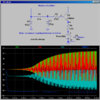Sorry I am little confused on your term, what did you mean? (should I have to see just 20uS to see its few cycles?)
If the frequency of a period waveform is f, the period is 1/f. 1/50kHz = 20us. Too see 5 (several) cycles, simulate for 5*20us = 100us.
Wow I really like simulation software! I used LTspice lot but never tried deeply. Just now I need to learn a feature quickly, that feature you used on 2nd post here. There is a 'small windows' which has various information about output waveform and output frequency of that oscillator. Once I tried to find output frequency on FM tx simulation but I had no idea.
How you did it Or where you clicked to get this window? ( sorry for simple question

)
1. Move the Mouse Cursor to the plot trace name at the top of the plot window.
2. Click Left Mouse button. A dashed line cursor will appear on the plot.
3. Move the Mouse Cursor over the vertical dashed line, a "
1" will appear on the line.
4. Push Left Mouse button and drag the line to the start time of the measurement. Release button. The readout box appears.
5. Move the Mouse Cursor back to the plot trace name at the top of the plot window.
6. Click Left Mouse button. A second dashed line cursor will appear on the plot.
7. Move the Mouse Cursor over the new vertical dashed line, a "
2" will appear on the line.
8. Push Left Mouse button and drag the line 2 to the end time of the measurement. Release button.
The readout box shows the delta time and voltage between the two cursors crosses.
Example here:




